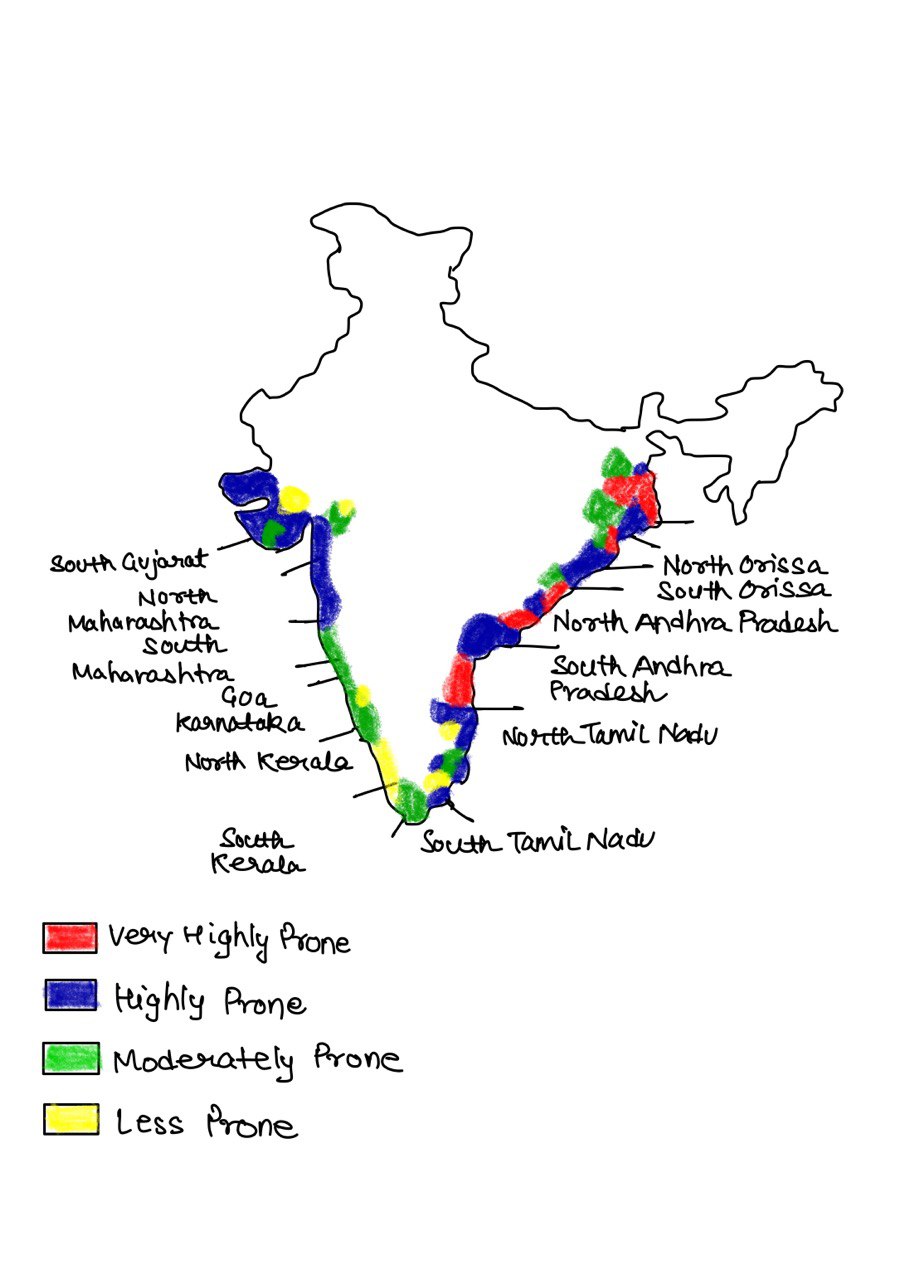Comment on the resource potentials of the long coastline of India and highlight the status of natural hazard preparedness in these areas.
Comment on the resource potentials of the long coastline of India and highlight the status of natural hazard preparedness in these areas.
India has a coastline of 7,516.6 km, touching 13 states and UTs, with a vast Exclusive Economic Zone (EEZ) of over 2.3 million sq km. This long coastline is rich in natural, economic, and strategic resources. However, it is also vulnerable to natural hazards like cyclones, tsunamis, and sea-level rise.
Resource Potentials of India’s Long Coastline
-
Marine Resources
- Fisheries: Over 4 million people depend on marine fishing, India is the third-largest fish producer globally (FAO, 2022).
- Aquaculture zones and brackish water have rich potential in states like Andhra Pradesh and Kerala.
-
Mineral Wealth
- Beach placer deposits: Monazite (largest deposit is in India), ilmenite, and rutile (e.g., Tamil Nadu, Odisha coast).
- Offshore oil & natural gas: Mumbai High, KG Basin (Andhra Pradesh), and Cambay Basin.
-
Trade & Port Economy
- 13 major and ~200 non-major ports handle ~90% of India’s external trade by volume.
- Maritime trade hubs of India are Mumbai, Kandla, Chennai, Kochi and Vishakhapatnam.
-
Tourism and Cultural Resources
- Coastal tourism (Goa, Kerala backwaters ad Andaman Islands) boosts local economy.
- Cultural heritage sites (e.g., Konark Temple, Rameswaram, Mamallapuram) are located near coasts.
-
Renewable Energy Potential
- Offshore wind farms (Tamil Nadu and Gujarat coast) hold both economic and climate action potential.
- Tidal energy potential in Gulf of Khambhat, Gulf of Kutch and Sunderbans.
-
Blue Economy
- Sagarmala Project for port-led development.
- Draft Blue Economy Policy 2021 focuses on fisheries, tourism, marine biotechnology, and coastal livelihood development.
Status of Natural Hazard Preparedness in Coastal Regions
India’s coastline is vulnerable to cyclones, tsunamis, storm surges, coastal erosion, and sea-level rise due to climate change.
-
Institutional Mechanisms
- National Disaster Management Authority (NDMA) and State Disaster Management Authorities (SDMAs) provide overall direction and superitendance in disaster management.
-
Early Warning Systems
- Satellite-based cyclone prediction and real-time alerts via INCOIS, IMD, and ISRO.
- Indian National Centre for Ocean Information Services (INCOIS) in Hyderabad provides early warnings for tsunamis and storm surges.
-
Infrastructure and Capacity Building
- Cyclone shelters, embankments, and saline-resistant infrastructure (especially in Odisha and Andhra Pradesh) have been in place.
- Coastal Regulation Zone (CRZ) norms enacted aim to restrict hazardous constructions.
-
Community Participation
- Regular disaster preparedness training and mock drills by NDRF and NGOs boost confidence and ensure timely mitigation.
- Cyclone risk mitigation projects (NCRMP Phase I & II) have been implemented in Odisha, Andhra Pradesh, Tamil Nadu.
-
Legal framework
- The NDMA 2005 provides overarching legal framework for disaster management.
- Cyclone and Tsunamis have been recognized as disaters under NDMA 2005.
-
Internaltional cooperation
- India is proactive member of SCO, BIMSTEC and IORA where best practices on coastal disater management are shared along with humanitarian assistance.
- The country is considered a leader in predicting coastal disaster risks through the Indian Tsunami Early Warning Centre (ITEWC), providing timely alerts to the Indian Ocean region.
India’s long coastline is both an economic asset and an environmental challenge. Leveraging its potential through sustainable blue economy models, while investing in climate-resilient infrastructure, community awareness, and disaster risk reduction, is key to ensuring inclusive coastal development.
Answer Length
Model answers may exceed the word limit for better clarity and depth. Use them as a guide, but always frame your final answer within the exam’s prescribed limit.
In just 60 sec
Evaluate your handwritten answer
- Get detailed feedback
- Model Answer after evaluation
Model Answers by Subject
Crack UPSC with your
Personal AI Mentor
An AI-powered ecosystem to learn, practice, and evaluate with discipline

